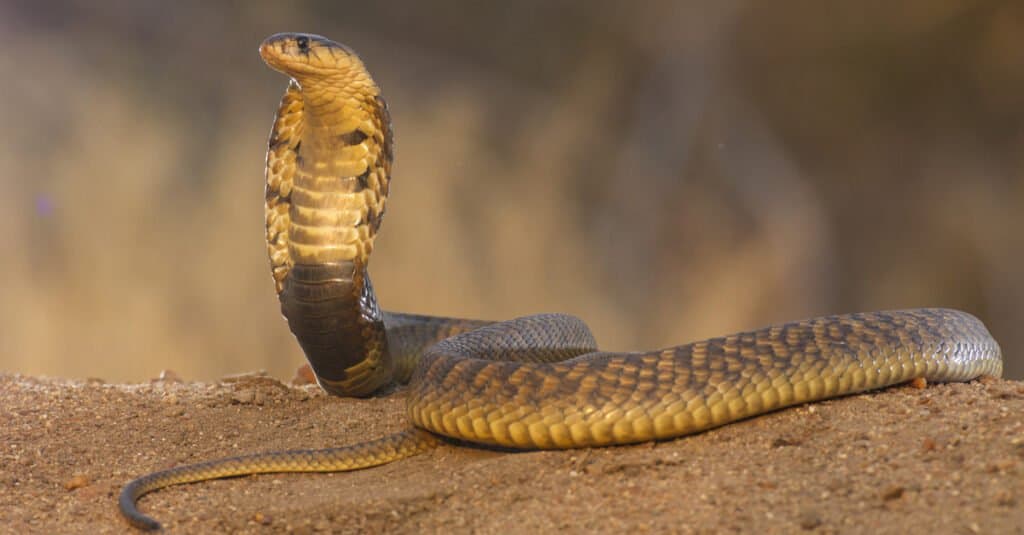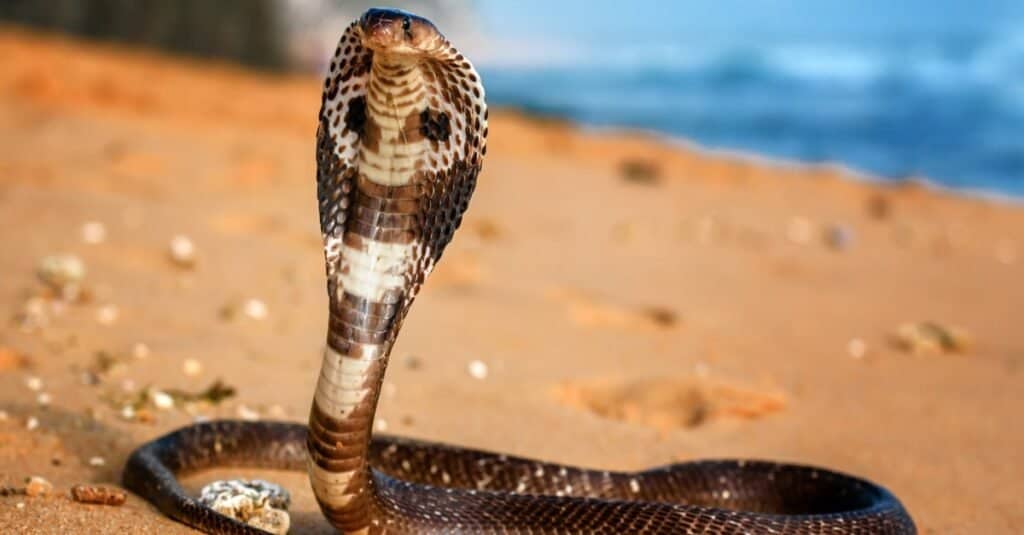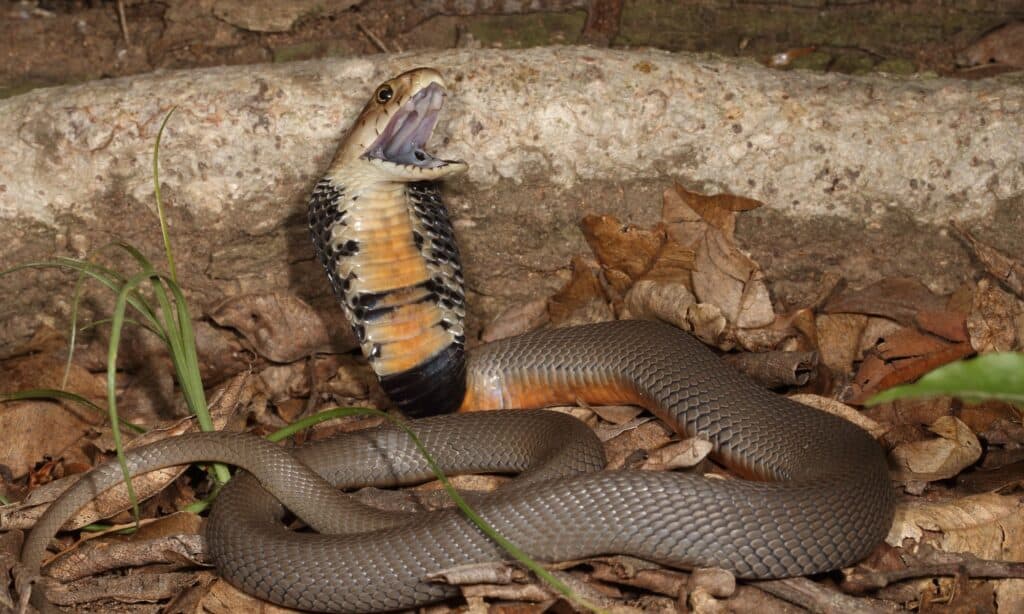Cobras are some of the most venomous snakes in the world. True cobras from the Naja genus vary in color and size. But most share similar features, such as long, slender bodies and the ability to raise the front part of their bodies off the ground and flatten their necks. And with the exception of two species (Indian and Caspian cobras), cobras have spitting adaptions. Not only can these snakes inject venom through bites, but they can also spit venom at their victims, often aiming for the face and eyes. You may have some clue as to how big cobras can get, but how do these snakes compare against each other? Check out this cobra size comparison and discover just how big the different kinds get. Plus, learn about the largest cobra ever caught and where you might encounter these snakes.
Note: This article refers to “true” cobras in the Naja genus, which doesn’t include king cobras, rinkhals, shield-nosed cobras, and a few more.
Types of Cobras: Cobra Size Comparison
Let’s compare a few of the largest cobras, including the smallest within the genus.
Forest Cobra

Cobra size comparison: Forest cobras are the largest true cobra species
©NickEvansKZN/Shutterstock.com
The forest cobra is the largest of the true cobras. On average, they measure between four and seven feet. But the largest of the species can reach up to 10 feet long. To compare, the average height of an NBA player is 6’6’’. On the large end, forest cobras can be as long as a small moving truck. And they weigh between four and eight pounds. Forest cobras live in the central regions of Africa, and they inhabit forests and woodlands.
Egyptian Cobra

Egyptian cobras can weigh up to 20 lbs.
©Stu Porter/Shutterstock.com
The Egyptian cobra is one of the most medically significant snakes in North Africa. These large cobra species reach an average of 4.6 to six feet long. But they have been known to grow up to 8.5 feet. And they can weigh up to 20 pounds. If you could compare this snake to objects or other animals, how would they compare? Well, an Egyptian cobra is about as long as a small elephant or a king-sized bed. These snakes live in scattered regions of North Africa, where there are semi-desert areas and dry to moist savannas.
Monocled Cobra

Monocled cobras are named for the monocle-shaped design on the back of their hoods.
©iStock.com/ePhotocorp
The monocled cobra has a distinct O-shaped pattern on its hood. This cobra species is between four and five feet long. However, large species have been recorded around 7.5 feet long. The monocled cobra can measure around the size of Shaquille O’Neal, who has a height of 7’1’’. These snakes are native to Asia, from India to China, Cambodia, and Vietnam. And they inhabit swamps, paddy fields, and mangroves.
Indian Cobra

Indian cobra spreading its hood to show that it’s dangerous.
©Vova Shevchuk/Shutterstock.com
Indian cobras are one of the four snakes responsible for the most snake bites in India. These cobras range between three and five feet, on average. On rare occasions, some Indian cobras can reach seven feet long. They can weigh up to 20 pounds. But typically weigh between five and six pounds. For a visual representation, Indian cobras can be as long as a giraffe’s neck, a pool table, or a Nile crocodile. This species can be found throughout the subcontinent of India, except for extreme deserts and high altitudes. You can most typically find them in forests, plains, wetlands, agricultural fields, and even urban areas.
Mozambique Spitting Cobra

Mozambique Spitting Cobra has a slate-grey, blue, olive or tawny brown-black upper body, while its scales have black edges.
©NickEvansKZN/Shutterstock.com
The Mozambique spitting cobra is the smallest of the true cobras. The average adult measures between three and 3.5 feet. However, they can grow as long as five feet. And they weigh around 10 to 15 pounds. They live in the southeastern regions of Africa, where they inhabit savannas in tropical and subtropical areas.
Cobra Size Comparison Chart
| Cobra | Size in Length (How Big Do They Get?) |
|---|---|
| Forest Cobra | 10 feet |
| Egyptian Cobra | 8.5 feet |
| Monocled Cobra | 7.5 feet |
| Indian Cobra | 7 feet |
| Mozambique Spitting Cobra | 5 feet |
What is the Largest Cobra Ever Caught?
The forest cobras are the largest species within the true cobra genus. And the largest forest cobra on record was 10 feet six inches long. But let’s compare that with the king cobra, which is not considered a true cobra.
The longest king cobra on record was a whopping 18.8 feet long! That is about the size of an adult giraffe.
Places You’re Most Likely to Encounter Cobras
True cobras live in Africa and Southern Asia. And where you can find them depends on their preferred habitats. Each species is different, so they have different needs. As its name suggests, forest cobras live in forests and woodlands in Central Africa. While Mozambique spitting cobras live in tropical savannas in Southeast Africa. And Indian cobras are found in many environments, including urban and residential areas.
The photo featured at the top of this post is © Vova Shevchuk/Shutterstock.com
Discover the "Monster" Snake 5X Bigger than an Anaconda
Every day A-Z Animals sends out some of the most incredible facts in the world from our free newsletter. Want to discover the 10 most beautiful snakes in the world, a "snake island" where you're never more than 3 feet from danger, or a "monster" snake 5X larger than an anaconda? Then sign up right now and you'll start receiving our daily newsletter absolutely free.
Thank you for reading! Have some feedback for us? Contact the AZ Animals editorial team.






